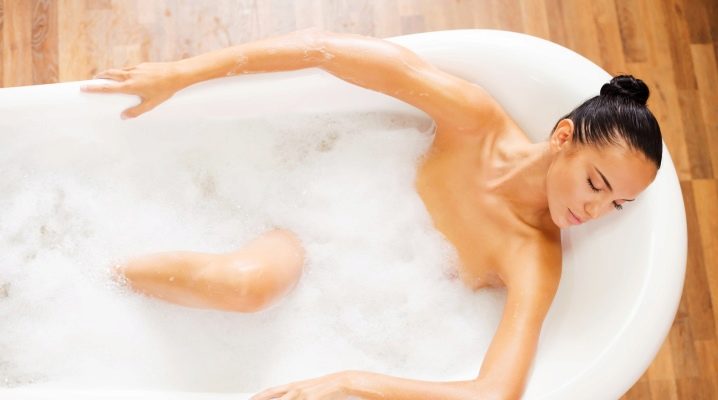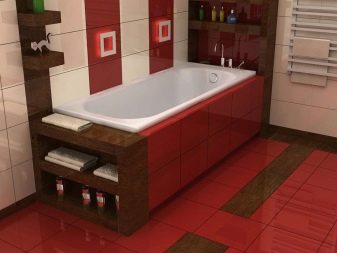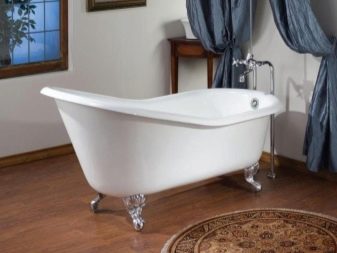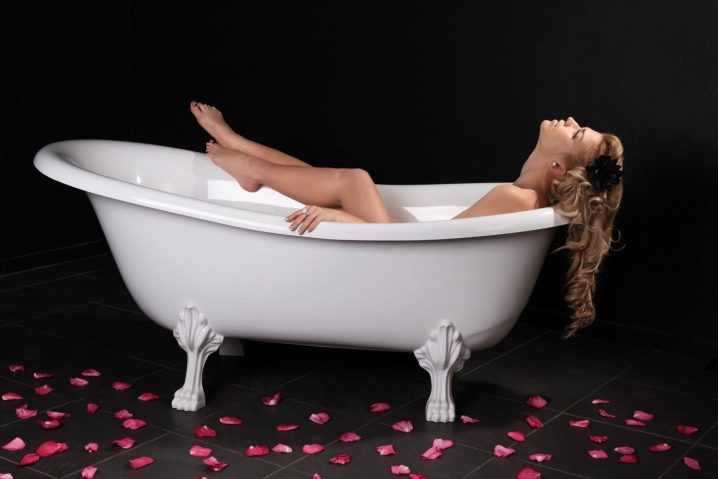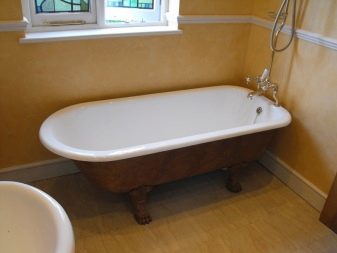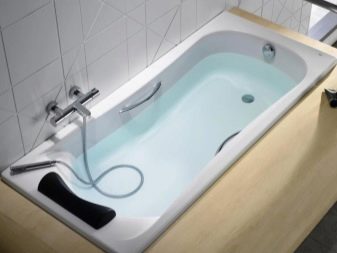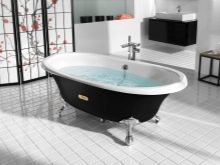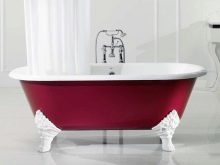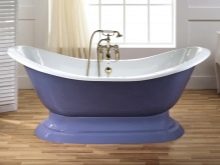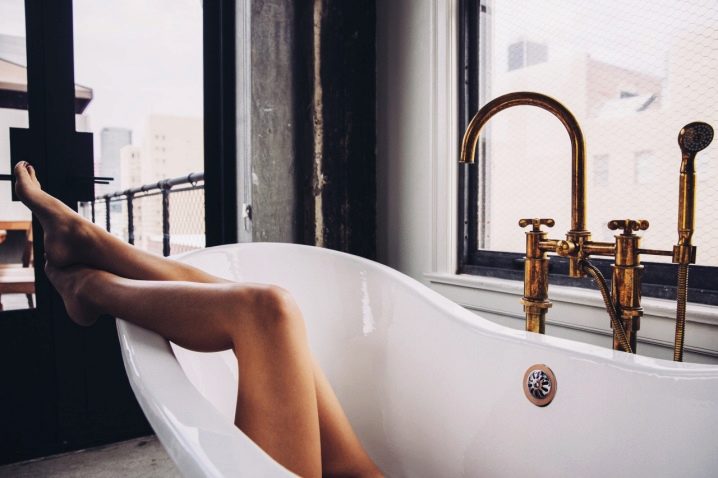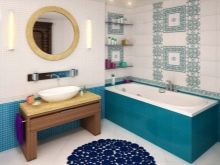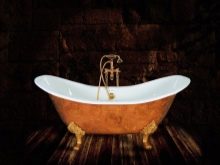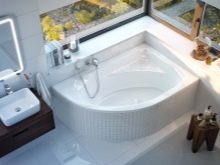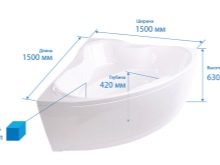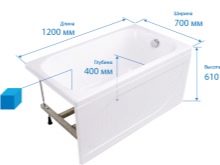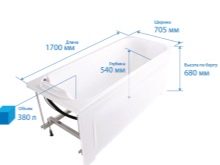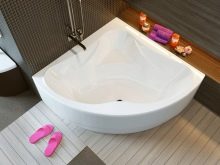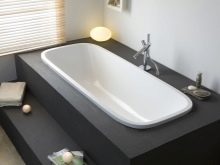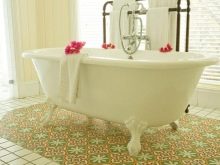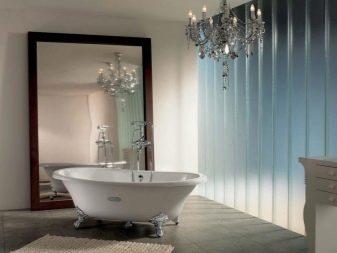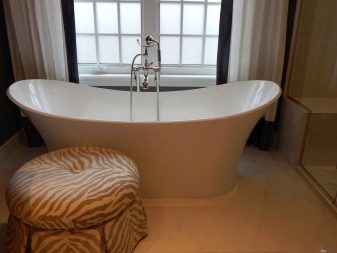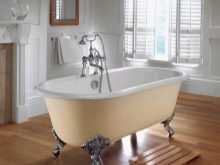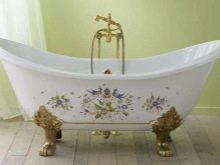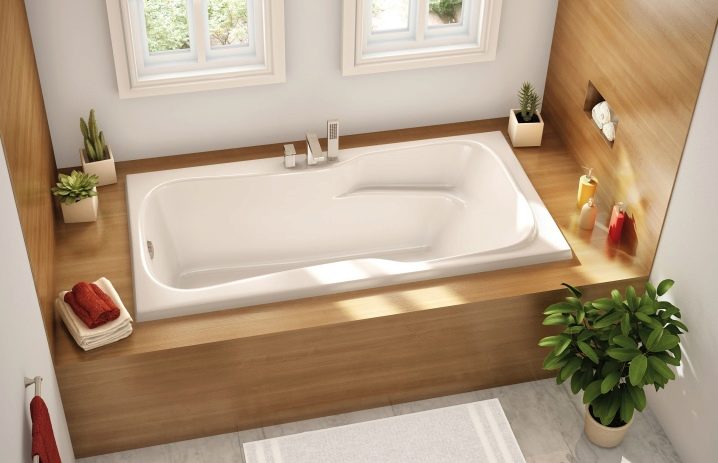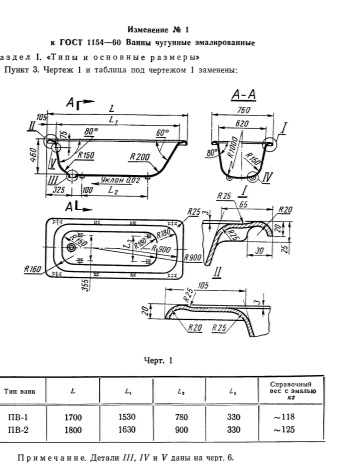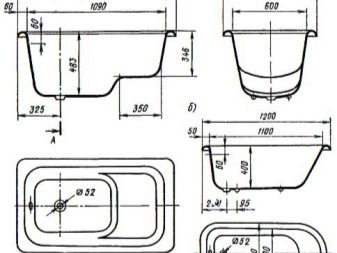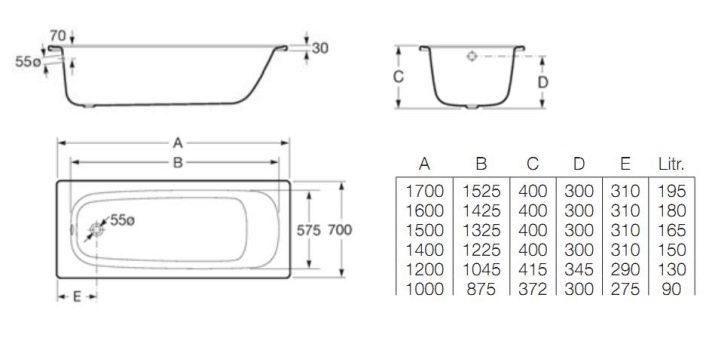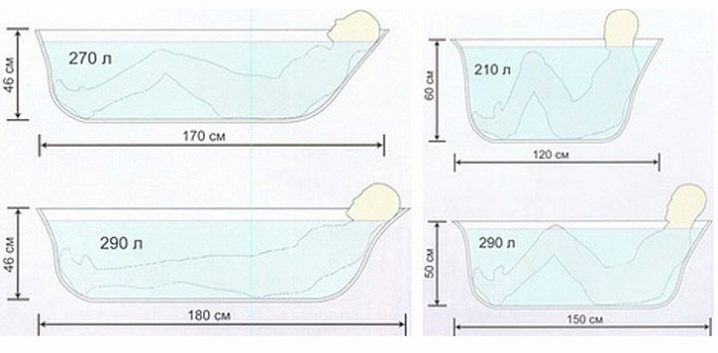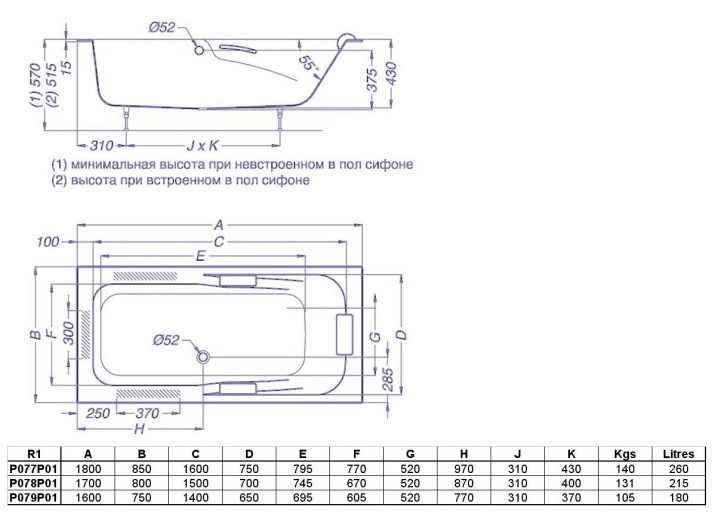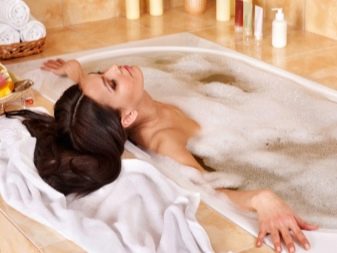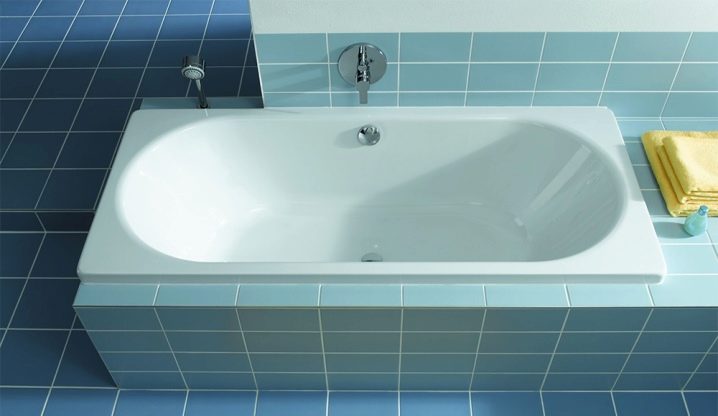We select the optimal size of the cast-iron bath
Despite the variety of acrylic baths, cast-iron bowls do not lose their popularity. This is due primarily to the reliability and durability of the design, as well as at least 30 years of service life.
The times when the cast-iron fonts were a very heavy and rather bulky appearance, the construction of an exceptionally rectangular shape of standard sizes was over. Today there are several options on the market in terms of shape, performance of cast-iron baths, as well as models of various sizes.
Special features
The composition of the iron baths compounds of iron with carbon, which provides increased strength of the product and its resistance to mechanical and vibration loads. Carbon is usually represented by cement or graphite.The latter may have a spherical shape, and therefore the product is characterized by greater strength.
Cast iron bath has many advantages.
- wear resistance - such a bath is not deformed during operation and even with increased mechanical loads;
- due to the increased strength of the product, it is suitable for use by several users at the same time, as well as optimally for people with high weight;
- the heat transfer of cast iron is minimal, so the water collected in such a bath cools down for a long time and unnoticeable to the user, while it is important that the walls of the tank do not heat up;
- resistance to temperature extremes;
- ease of care, the ability to clean the bath with any cleaning products;
- antibacterial characteristics and ability to self-cleaning due to the presence of enamel coating, which is devoid of pores.
Among the disadvantages of bathtubs made of cast iron are usually noted a large weight of the product: 100-120 kg for a bath with a size of 150x70 cm, and imported models are usually 15-20 kg lighter than their Russian counterparts. Today's models are much lighter than their Soviet prototypes, since they have thinner, but no less durable walls.However, the cast-iron bath in any case will be heavier than acrylic. However, this disadvantage is important only when transporting and assembling the bowl, the large weight of the bath does not affect the further operation.
Despite the advantages of enamel coating, it has a significant "minus" - is quite slippery. To increase the safety of the product, it is recommended to use a rubberized mat.
The production process of cast iron tubing is labor intensive and complex.That causes its higher cost. However, this “minus” is leveled by a long (up to 30 years on average) period of operation and unpretentious care.
The complexity of the casting process of cast iron is due to another design flaw - the internal space of the bowl is difficult to give shape, anatomically identical to the shape of the human body.
Installation of the device does not differ from the ways of installing a bath of a different type.
Forms and types
Cast iron is a material that does not differ in plasticity, and therefore a wide variety of forms cannot be expected from such products. However, if you are looking for a classic rectangular design, you will not be limited in choice.It is this form, that is, its modification with rounded edges, is the most popular.
Pig-iron oval font is made by hand.that increases the value of the product. However, it looks elegant and respectable, is usually detached, equipped with legs. The most ergonomic is considered the triangular shape of the bowl, since it is mounted in the corner of the room. However, its weight can reach 150-170 kg, so it is not suitable for all types of buildings.
As for the sizes, manufacturers offer both compact so-called sit-down baths and more overall bowls.
The depth of the bath is determined by the distance from the bottom of the bowl to its overflow hole. As a rule, deeper fonts are produced by domestic brands, this figure is 40-46 cm. As practice shows, such bowls turn out to be more convenient compared to imported counterparts, the depth of which varies between 35-39 cm.
Depending on the method of installation of the bath, it can be:
- wall - the bowl is installed along one of the walls of the room, usually has a rectangular shape;
- angular - it is installed in the corner of a room between two perpendicular walls, usually such a bowl has the shape of a triangle or a quarter of a circle, suitable for small rooms;
- free-standing - it is installed at a distance from the walls or in the middle of the bathroom; it is made in the shape of a rectangle, oval or circle;
- built-in - assumes installation of a bowl in a podium, its side only several centimeters rises above the level of a pedestal.
The outer walls of the wall and corner models are usually covered with panels, while freestanding models usually have decorative exterior walls. It looks, of course, beautiful, but the owner is required to care not only for the inner, but also for the outer walls.
For ease of use, structures can be equipped with handles, rubberized areas. The use of such baths will be appreciated by the elderly and disabled.
Today, almost all baths, regardless of the material of manufacture, can be equipped with a hydromassage system. It is a nozzle and other elements that provide a soft massage with air and water-air jets, beating under pressure.Cast iron, along with artificial stone, is the optimal material for a hydromassage bowl. Due to the high density and strength of the material, it does not vibrate, which makes the use of the whirlpool function more comfortable.
The cast-iron bath can have a classic white finish or have a color coating. These are beige and bluish bowls that are suitable for any type of interior. The outer part of the device may have a wider color palette. Preference should be given to models coated with powder dye.
The colored surface will turn out to be homogeneous and will remain throughout the entire period of using the device.
Standards dimensions
The sizes of cast iron baths are quite diverse. Undoubtedly, one of the most convenient models is a 180x80 cm bowl. Even a tall adult can comfortably lie down with his legs stretched out. However, it does not fit into every bathroom of an apartment building. It is important that the bath of the selected width "passed" through the doorway of the bathroom.
However, if you tilt its bowl, the width of the cargo will be reduced by 40-50 cm.
GOST approved the following sizes of standard cast iron baths. Their length can be 150, 160 or 170 cm, width - 70 or 75 cm, depth - not less than 40 cm (relevant only for domestic products).
According to the standard classification of baths, taking into account their dimensions, cast-iron bowls can be of several types.
Little ones
As a rule, their size starts from 120x70 or 130x70 cm, although in the collection of some manufacturers you can find bowls of 100x70 cm. They are optimal for small rooms, but you can only use them in the half-sitting position. The weight of the structure is about 100 kg. As a rule, it is not so convenient to wash in small bowls, however this disadvantage can be made less noticeable if the bowl has a high back. By the way, this model looks incredibly stylish and authentic.
Standard
Such designs have dimensions of 140x70 or 150x70 cm and can fit in the bathroom of most standard apartment buildings. Their weight is 130-135 kg. The most common standard (or medium sized) bowls are 150x60 cm, 150x70 cm and 150x75 cm, as well as a more compact bowl 145x70 cm.
Large
These bowls exceed the standard in size. Their length ranges from 170 to 180 cm, the standard width is from 70 to 80 cm (that is, the dimensions of the bowl are 170x80 and 180x70 cm). There are also “intermediate” versions, the dimensions of which are 170x75 and 180x75 cm, respectively.Their weight is 150 kg or more, so this bowl is mounted only on concrete floors.
And also large baths are considered to be 170x70, 170x75, 175x70, 170x75, 175x75, 175x80, 170x85 and 180x75 cm.
More dimensional models (for example, 190x80 cm) are rare, due to the low demand for them.
The approximate weight of the cast iron baths is not just given - it directly depends on the size of the bowl. At the same time, during operation, the weight of a bowl with water and a person can reach 500 kg. This load is not intended for houses with wooden or old floor. In other words, choosing the size of the bath, you should focus not only on the parameters of the room and personal preferences, but also take into account the load on the floor.
As a rule, each manufacturer has its own dimensional grid. Thus, the Chinese brand Aqualux standard considers the cup 150x70 cm, and the Italian manufacturer Roca - baths with a size of 160x70 cm.
Corner structures usually have a side length of 120-170 cm (domestic brands) and 100-180 cm (imported models). The most convenient is an equilateral bath with a side length of 140-150 cm. Asymmetrical models can have different sizes (160x70, 160x75, 170x100 cm - the parameters of the longest and widest sides are indicated).Sometimes the dimensions of asymmetric corner models may correspond to the dimensions of standard baths (for example, 150x75), but due to the irregular shape they look more voluminous.
That is why when choosing asymmetric models, it is more correct to focus on the volume of the bowl, and not only on the dimensions.
Usage tips
When purchasing a cast-iron bath, it is necessary to calculate not only its length and width, but also the load on the overlap, which it will exert during operation.
Choosing a font made of cast iron, evaluate the condition of its walls. They should not have rough edges, dents, chips - all these are signs of a violation of the production process, which means that the bath will not last for a long time. The wall thickness should be at least 5 mm, the edges should have good processing (to be smooth, without "burrs"). The thickness of the enamel coating on the bottom of the bath should be at least 1.5 mm, on the walls and sides of at least 1 mm.
Cast iron bath is quite unpretentious in the care. To keep it attractive, rinse and wipe the bowl after each use. Ideally, the enamel should be wiped with a soft sponge, rubbed with soap or dripping on it with dishwashing liquid. It is important to wash off the soap layer well.
It is unacceptable to put metal buckets and basins directly on the bottom of the font. If the need arises, lay a rag between the bottom of the bowl and the bottom of the bucket. When washing pets, use special silicone linings and mats.
This will prevent the formation of scratches on the surface of the bath and cracking of the enamel.
Despite the strength of the structure, it is not necessary to throw objects into it, pour out dirty water. In the latter case, the dirt particles will become a kind of abrasive, negatively affecting the state of the enamel.
It is unacceptable to use aggressive acids to clean the iron bowl. Of course, it will return its shine and whiteness, but not for long. The use of acids leads to the appearance of micro-cracks on the enameled surface. Dirt will clog in them and over time the bath will become gray and dull.
You will learn more about the size of the cast-iron baths in the following video.
